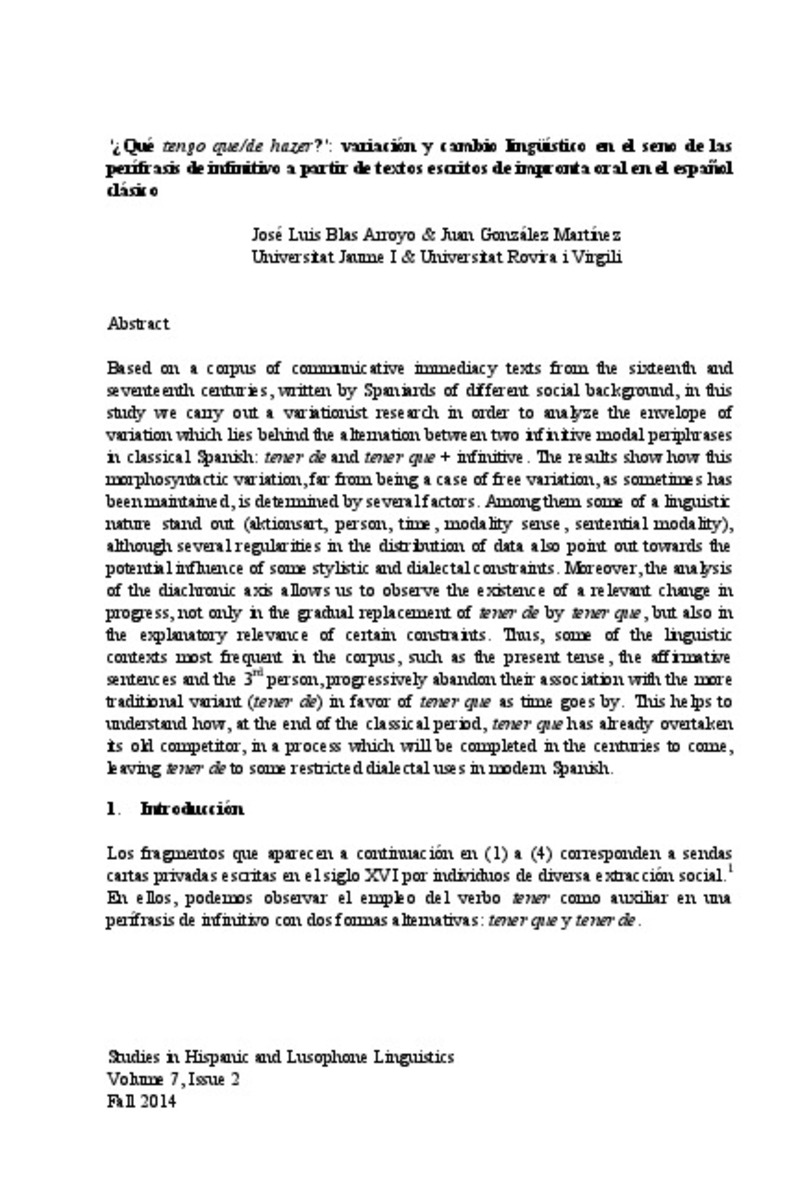Mostrar el registro sencillo del ítem
Qué tengo que/de hazer?": variación y cambio lingüístico en el seno de las perífrasis de infinitivo a partir de textos escritos de impronta oral en el español clásico
| dc.contributor.author | Blas-Arroyo, José Luis | |
| dc.contributor.author | González-Martínez, Juan | |
| dc.date.accessioned | 2015-06-30T09:14:11Z | |
| dc.date.available | 2015-06-30T09:14:11Z | |
| dc.date.issued | 2014-10 | |
| dc.identifier.citation | BLAS ARROYO, José Luis; GONZÁLEZ MARTÍNEZ, Juan. ‘¿ Qué tengo que/de hazer?’: variación y cambio lingüístico en el seno de las perífrasis de infinitivo a partir de textos escritos de impronta oral en el español clásico. Studies in Hispanic and Lusophone Linguistics, 2014, 7.2: 241-274. | ca_CA |
| dc.identifier.uri | http://hdl.handle.net/10234/125444 | |
| dc.description.abstract | Based on a corpus of communicative immediacy texts from the sixteenth and seventeenth centuries, written by Spaniards of different social background, in this study we carry out a variationist research in order to analyze the envelope of variation which lies behind the alternation between two infinitive modal periphrases in classical Spanish: tener de and tener que + infinitive. The results show how this morphosyntactic variation, far from being a case of free variation, as sometimes has been maintained, is determined by several factors. Among them some of a linguistic nature stand out (aktionsart, person, time, modality sense, sentential modality), although several regularities in the distribution of data also point out towards the potential influence of some stylistic and dialectal constraints. Moreover, the analysis of the diachronic axis allows us to observe the existence of a relevant change in progress, not only in the gradual replacement of tener de by tener que, but also in the explanatory relevance of certain constraints. Thus, some of the linguistic contexts most frequent in the corpus, such as the present tense, the affirmative sentences and the 3rd person, progressively abandon their association with the more traditional variant (tener de) in favor of tener que as time goes by. This helps to understand how, at the end of the classical period, tener que has already overtaken its old competitor, in a process which will be completed in the centuries to come, leaving tener de to some restricted dialectal uses in modern Spanish. | ca_CA |
| dc.format.extent | 33 p. | ca_CA |
| dc.format.mimetype | application/pdf | ca_CA |
| dc.language.iso | spa | ca_CA |
| dc.publisher | De Gruyter | ca_CA |
| dc.relation.isPartOf | Studies in Hispanic and Lusophone Linguistics. Volume 7, Issue 2, Fall 2014 | ca_CA |
| dc.rights.uri | http://rightsstatements.org/vocab/CNE/1.0/ | * |
| dc.subject | modal periphrases | ca_CA |
| dc.subject | language contact | ca_CA |
| dc.subject | historical sociolinguistics | ca_CA |
| dc.subject | language change | ca_CA |
| dc.subject | corpus linguistics | ca_CA |
| dc.subject | texts of communicative immediacy | ca_CA |
| dc.subject | spanish | ca_CA |
| dc.subject | social factors | ca_CA |
| dc.title | Qué tengo que/de hazer?": variación y cambio lingüístico en el seno de las perífrasis de infinitivo a partir de textos escritos de impronta oral en el español clásico | ca_CA |
| dc.type | info:eu-repo/semantics/article | ca_CA |
| dc.identifier.doi | http://dx.doi.org/10.1515/shll-2014-1167 | |
| dc.rights.accessRights | info:eu-repo/semantics/openAccess | ca_CA |
| dc.relation.publisherVersion | http://www.degruyter.com/dg/viewarticle/j$002fshll.2014.7.issue-2$002fshll-2014-1167$002fshll-2014-1167.xml | ca_CA |
| dc.type.version | info:eu-repo/semantics/publishedVersion |
Ficheros en el ítem
Este ítem aparece en la(s) siguiente(s) colección(ones)
-
FIL_Articles [317]







